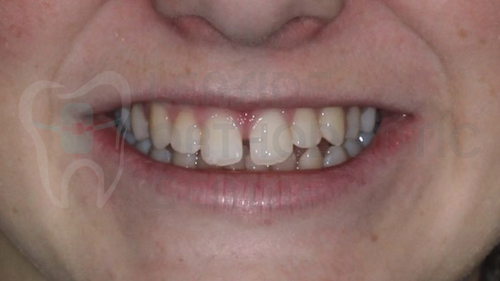Differences between Clear Braces and Invisalign®
- Dr. Emel Arat

- Feb 13, 2022
- 4 min read
With advances in orthodontics, you’re no longer restricted to visible traditional braces that attract attention to your teeth. You can wear clear braces or Invisalign® to straighten your teeth. But they're not the same. To choose the best treatment option, understand the differences between clear braces and Invisalign®.

What are clear braces and Invisalign®?
Clear braces and Invisalign® are orthodontic treatments used to straighten teeth. They’re less noticeable than traditional braces, ideal for patients seeking discrete treatment options. If you’re self-conscious about wearing shiny metal braces, consider getting clear braces or Invisalign®. Clear braces are made from ceramic material. Your Toronto orthodontist can custom-build clear braces that match your teeth. Invisalign® uses clear plastic aligners to move your teeth into the desired position. Both treatment options are aesthetic and almost invisible.

Clear braces vs. Invisalign®, what are the differences?
Clear braces and Invisalign® are excellent choices for straightening teeth without affecting your appearance like traditional metal braces. Each option has its benefits and drawbacks.
Mechanics: Clear braces are similar to metal braces because they both use brackets connected by wires and bonded to the surface of the teeth. These brackets are tightened to move teeth to the desired position. Invisalign® uses plastic aligners fitted over upper and lower teeth. Your Toronto orthodontist will guide you on how to change your aligners every few weeks to straighten your teeth.
Oral Hygiene: Clear braces are permanently attached to your teeth. So, food particles and plaque can accumulate in hard-to-reach spaces. Invisalign® is removable, allowing you to brush and floss your teeth more easily than braces.
Effectiveness: Clear braces and Invisalign® can straighten teeth for kids, teens, and adults. Since Invisalign® is removable, some kids and teens won't remember to put them back in their mouth. For this reason, clear braces are often recommended for some children and teens where compliance is a concern. Invisalign® aligners are less noticeable than clear braces, ideal for adults who will be committed to wearing them. Badly crooked teeth may require clear braces.
Food Restrictions: If you wear clear braces, avoid hard foods such as nuts,seeds, popcorn, and any sticky foods. Invisalign® does not have food restrictions. You can remove them and eat whatever you like. However, you should not eat or drink anything other than water when the aligners are in your mouth.
Comfort: Invisalign® uses soft, flexible, custom-fit plastic aligners, reducing the risk of discomfort. This orthodontic treatment is less irritating than clear braces. However, Invisalign® often costs more than clear braces.
Office Visits: Clear braces require slightly more frequent trips to your orthodontist for bracket adjustments. With Invisalign®, your Toronto orthodontist will provide trays for you to take home. You’ll switch your trays at the designated time, eliminating frequent office visits.
What can Invisalign® not fix?
Invisalign® can fix small to medium size gaps between the teeth. However, you’ll need braces to close large teeth gaps. Invisalign® treatment may not fully correct severe bite discrepancies or extremely overcrowded teeth. If your teeth are crooked and short, Invisalign® may not deliver the desired outcome. In this case, your Toronto orthodontist will recommend braces to shift your teeth into proper alignment. It is important to see an orthodontic specialist to help determine which treatment option is best suited to your dental needs.
Can Invisalign® make gum recession worse?
The gums and bones surround and support a tooth. As a tooth moves, the gums and bones around the tooth remodel. However, gum recession or active periodontal disease can be exacerbated with tooth movement. To reduce the risk of gum recession, get Invisalign® aligners from a reputable clinic like Leaside Orthodontic Centre.
Who is not eligible for Invisalign®?
Invisalign® is not for everyone. Patients with many dental implants, bridges or active TMJ disorder may or may not be eligible for Invisalign®. You may not be a good candidate for this orthodontic treatment if you have dental conditions that require oral surgery. Invisalign® is recommended for patients with mild to moderate teeth misalignment, overbite, or open bite. To check whether you’re eligible for Invisalign®, visit Leaside Orthodontic Centre, a trusted orthodontic specialist.
Does Invisalign® work permanently?
Invisalign® can provide a permanent solution to straighten your teeth and keep them that way.Note that orthodontic makeovers require maintenance and aftercare. You’ll need to wear a retainer in the long term to prevent your teeth from shifting. Your teeth will be susceptible to shifting, particularly in the first few months after Invisalign® treatment. Your orthodontic specialist will guide you on the best way to wear your retainers. Typically, retainers are worn full-time for the first few months. Then, gradually reduce retainer usage as your teeth stabilize over time. With proper aftercare, your new smile can last a lifetime.
Does Invisalign® make teeth perfectly straight?
Yes, it does! Wearing Invisalign® aligners for 12-24 months will give you straighter teeth and the perfect smile. But your teeth can shift over time due to forces exerted by chewing, swallowing, biting, and simple aging. Wear retainers and follow your orthodontist's instructions to keep your teeth perfectly aligned for a lifetime.
Can Invisalign® help all teeth?
Invisalign® is not a magic pill for all orthodontic issues. Invisalign® treatment cannot correct severe open bites or extremely overcrowded teeth. It may also be ineffective for straightening badly rotated or crooked teeth. But don’t worry, you can rely on alternatives like ceramic braces and traditional metal braces to straighten your teeth. Visit Leaside Orthodontic Centre to consult with Dr. Arat on the best-customized treatment option for you.










Orange Dental is the best Dental Company in Toronto offering top-notch care friendly service and advanced treatments for a healthy bright smile